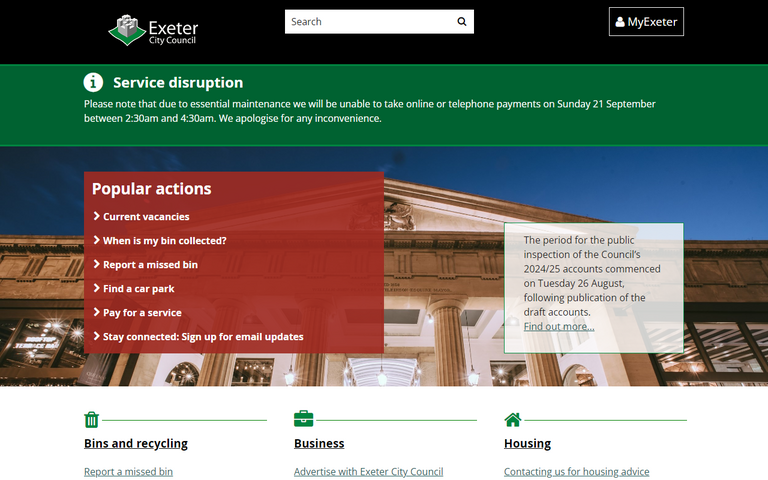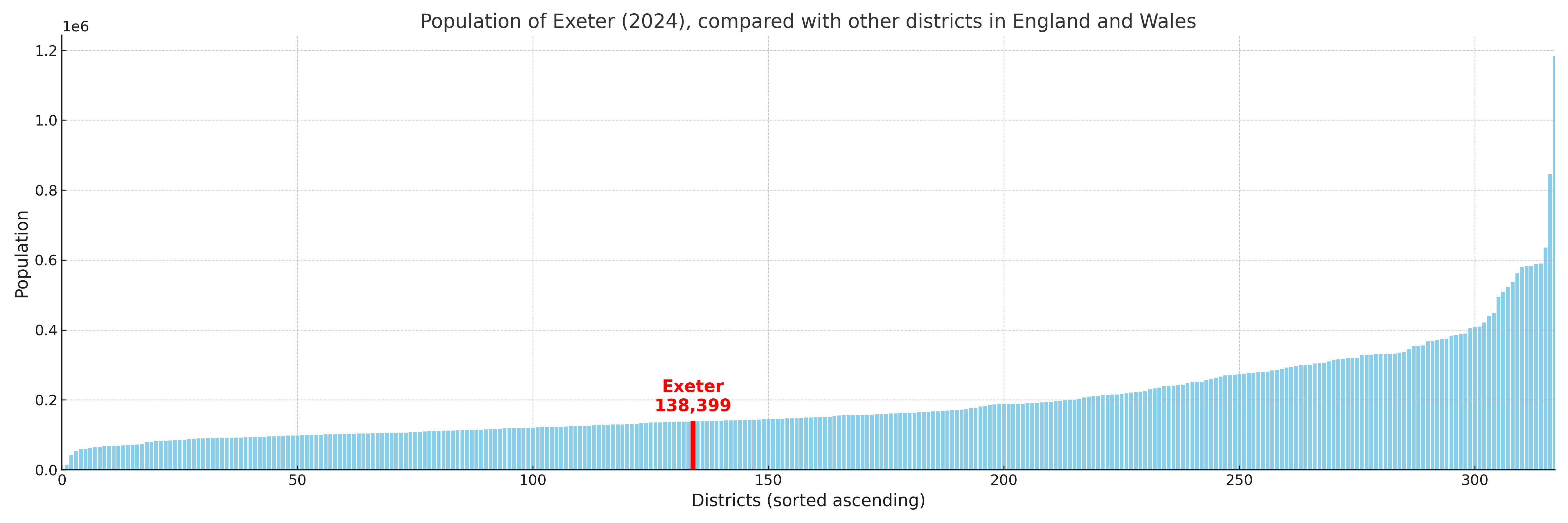Exeter
§ This page gives an overview of the Exeter local authority district, bringing together key facts, maps, and data to help you quickly understand the area. One of 361 district profiles on Baseview.
Overview ⁞ Exeter is a historic city on the River Exe, blending Roman origins, medieval architecture, and modern amenities. Its centre is dominated by Exeter Cathedral, surrounded by cobbled streets, shops, and cultural venues. The city’s historic quayside on the River Exe features converted warehouses, cafes, and walking trails, while the Royal Albert Memorial Museum highlights its heritage. Exeter is a gateway to Devon’s countryside, with easy access to the Exe Estuary, Dartmoor National Park, and the Jurassic Coast, combining urban vibrancy with proximity to scenic landscapes.
Exeter Boundary Map
This map shows the official boundary of the Exeter local authority district, based on the latest geographic data published by the Office for National Statistics (ONS). It provides a clear view of the district’s extent and helps you understand how the area fits within the wider regional and national landscape.
Contains OS data © Crown copyright and database right 2025. Source: Office for National Statistics licensed under the Open Government Licence v3.0.
The administrative boundary of Exeter can also be viewed on OpenStreetMap: District Boundary of Exeter.
Key Facts about Exeter
What region is Exeter in? Exeter is in the South West of England, a region within the UK.
What county is Exeter in? Exeter is located in the county of Devon.
Is Exeter a city? Yes, Exeter is a city. Exeter holds official city status as one of the 76 designated cities in the UK.
Who governs Exeter? The local authority for this district is: Exeter City Council - responsible for district-level services. Since Devon is a two-tier area, county-level services are handled by: Devon County Council.
▶ Official website of Exeter City Council 🔗 exeter.gov.uk

Which police force covers Exeter? Policing in Exeter is provided by Devon & Cornwall Police 🔗 devon-cornwall.police.uk, which serves 12 local authority districts: Cornwall ⁞ East Devon ⁞ Exeter ⁞ Isles of Scilly ⁞ Mid Devon ⁞ North Devon ⁞ Plymouth ⁞ South Hams ⁞ Teignbridge ⁞ Torbay ⁞ Torridge ⁞ West Devon.
Constituencies in Exeter
Exeter is divided into 2 parliamentary constituencies, listed below in alphabetical order.
A constituency is a specific geographical area that elects one Member of Parliament (MP) to represent them in the House of Commons. The United Kingdom is divided into 650 parliamentary constituencies. We have this list page for easy browsing of all UK parliamentary constituencies: List of Constituencies.
Wards in Exeter
Exeter is divided into 13 wards, listed below in alphabetical order.
- Alphington
- Duryard and St James
- Exwick
- Heavitree
- Mincinglake and Whipton
- Newtown and St Leonard's
- Pennsylvania
- Pinhoe
- Priory
- St David's
- St Loyes
- St Thomas
- Topsham
In the UK, a ward is a subdivision of a local authority area, used mainly for electoral and statistical purposes. Defined by the ONS, wards represent the primary unit for local elections, each returning one or more councillors to the local council. Wards are also used as a key geography for presenting population and census data.
Parishes in Exeter
Exeter is entirely unparished—there are no civil parishes in this local authority district.
Parishes are the lowest tier of local government; where they don’t exist, those very local services and representation sit directly with the principal council.
Built-up Areas in Exeter
Exeter covers 5 built-up areas, listed below in alphabetical order.
- Clyst Honiton *
- Exeter *
- Ide *
- Topsham *
- West Clyst *
In the UK, a Built-up Area (BUA) is a continuous urban area of at least 20 hectares (0.2 km²), defined by the ONS as land where buildings are generally no more than 200 metres apart, such as towns, cities, or large villages. (Note: A BUA name marked with an asterisk (*) indicates that the area is situated partly in the district of Exeter.)
Exeter compared with other districts in the UK
This section shows how Exeter compares with other local authority districts in the UK, using a variety of measures and rankings.
Exeter has 13 electoral wards.

Exeter has a population of 138,399 (2024 mid-year estimate by ONS)

More local statistics and data for Exeter can be found on the ONS statistics for Exeter.